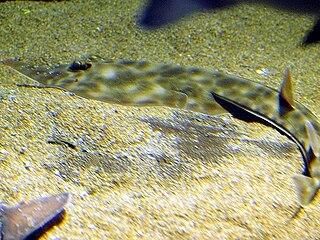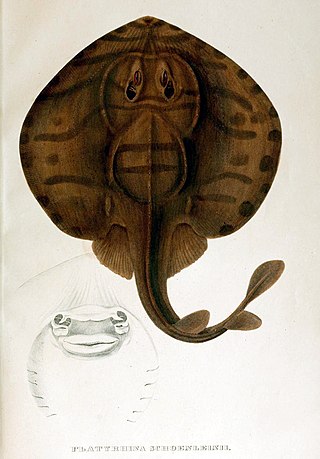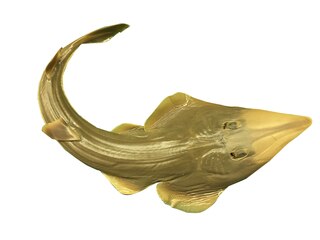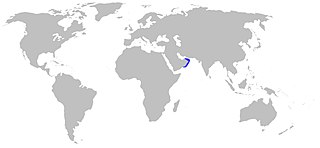
Myliobatiformes is one of the four orders of batoids, cartilaginous fishes related to sharks. They were formerly included in the order Rajiformes, but more recent phylogenetic studies have shown the myliobatiforms to be a monophyletic group, and its more derived members evolved their highly flattened shapes independently of the skates.

The guitarfish, also referred to as shovelnose rays, are a family, Rhinobatidae, of rays. The guitarfish are known for an elongated body with a flattened head and trunk and small, ray-like wings. The combined range of the various species is tropical, subtropical, and warm temperate waters worldwide.

The shovelnose guitarfish, Pseudobatos productus, is a ray in the family Rhinobatidae. It becomes mature at an estimated seven to eight years old. Males are between 90–100 cm (35–39 in) long, while females are around 99 cm (39 in) at that age. The ray can live up to 11 years, and full-grown sizes are around 120 cm (47 in) for males, and females reach 137 cm (54 in). They range from central California south to the Gulf of California. Morphological and genetic variations occur in the mitochondrial DNA in those found in the Gulf of California, evidencing their isolation from the rest. Because of this, the conservation of this species must be carefully managed to preserve the biological diversity. The shovelnose is considered to be a primitively developed ray, with many features of both sharks and rays.

Rhina ancylostoma, the bowmouth guitarfish, shark ray or mud skate, is a species of ray and a member of the family Rhinidae. Its evolutionary affinities are not fully resolved, though it may be related to true guitarfishes and skates. This rare species occurs widely in the tropical coastal waters of the western Indo-Pacific, at depths of up to 90 m (300 ft). Highly distinctive in appearance, Rhina ancylostoma has a wide and thick body with a rounded snout and large shark-like dorsal and tail fins. Its mouth forms a W-shaped undulating line, and there are multiple thorny ridges over its head and back. It has a dorsal color pattern of many white spots over a bluish gray to brown background, with a pair of prominent black markings over the pectoral fins. This large species can reach a length of 2.7 m (8.9 ft) and weight of 135 kg (298 lb).

The thornback guitarfish is a species of ray in the family Platyrhinidae, and the only member of its genus. Despite its name and appearance, it is more closely related to electric rays than to true guitarfishes of the family Rhinobatidae. This species ranges from Tomales Bay to the Gulf of California, generally in inshore waters no deeper than 6 m (20 ft). It can be found on or buried in sand or mud, or in and near kelp beds. Reaching 91 cm (36 in) in length, the thornback guitarfish has a heart-shaped pectoral fin disc and a long, robust tail bearing two posteriorly positioned dorsal fins and a well-developed caudal fin. The most distinctive traits of this plain-colored ray are the three parallel rows of large, hooked thorns that start from the middle of the back and run onto the tail.

Rhinobatos is a genus of fish in the Rhinobatidae family. Although previously used to encompass all guitarfishes, it was found to be polyphyletic, and recent authorities have transferred many species included in the genus to Acroteriobatus, Glaucostegus, and Pseudobatos.

The brown guitarfish is a species of fish in the Rhinobatidae family. It is found in western Pacific of Taiwan and the Philippines. Its natural habitats are open seas, shallow seas, coral reefs, and estuarine waters. The Taiwan guitarfish was formerly considered a distinct species, but is now considered a junior synonym.

The common shovelnose ray, giant shovelnose ray or giant guitarfish is a species of fish in the Rhinobatidae family found in the central Indo-Pacific, ranging from India to the East China Sea, Solomon Islands and northern Australia. It is found in shallow coastal areas to a depth of at least 100 m (330 ft), including mangrove, estuaries and reportedly also in freshwaters. It reaches up to 2.7 m (8.9 ft) in length, and is greyish-brown to yellowish-brown above with a paler snout.

The banded guitarfish, mottled guitarfish, prickly skate or striped guitarfish is a species of fish in the Trygonorrhinidae family. Originally Z. exasperata was placed in the Rhinobatidae family, however recent mitochondrial DNA analysis shows their placement into the new family of Trygonorrhinidae. They are found from shallow water to a depth of 200 m (660 ft) in the East Pacific from California, United States, to Mazatlan, Mexico, including the Gulf of California. The species has also been recorded further south, but this likely involves its close relative, the southern banded guitarfish.
Tarsistes philippii is a taxonomically dubious species of guitarfish, family Rhinobatidae. It is known only from a dried head from the Juan Fernández Islands off Chile. The head had a long, thin, flat snout, rounded at the tip like that of the goblin shark, and the underside covered with small stellate prickles except for the base. The head was covered with larger spinules, with six still larger ones forming a curve around the eye.

Wedgefishes are rays of the family Rhinidae, comprising eleven species in three genera. Classified in the order Rhinopristiformes along with guitarfishes and sawfishes, they have also been known as giant guitarfishes or sharkfin guitarfishes.

Glaucostegus, also known as giant guitarfishes, is a genus of large Indo-Pacific rays, with a single species, Glaucostegus cemiculus, in the East Atlantic, and Mediterranean. They were formerly classified in the family Rhinobatidae but are now recognized as a distinct family, Glaucostegidae.

Rhinopristiformes is an order of rays, cartilaginous fishes related to sharks, containing shovelnose rays and allied groups.

Trygonorrhinidae, the banjo rays, is a family of rays, comprising eight species in three genera. They were formerly classified in the family Rhinobatidae.
The false shark ray is a species of fish in the Rhinidae family and the only species in the genus Rhynchorhina. This rare ray is only known from shallow coastal Atlantic waters in Banc d’Arguin, Mauritania.

The panrays are a genus, Zanobatus, of rays found in coastal parts of the warm East Atlantic Ocean, ranging from Morocco to Angola. It is the only genus in the family Zanobatidae, which traditionally has been included in the Myliobatiformes order, but based on genetic evidence it is now in Rhinopristiformes or a sister taxon to Rhinopristiformes.

Acroteriobatus is a genus of fish in the Rhinobatidae family. Although its constituent species were previously assigned to Rhinobatos, recent authors treat it as distinct.

Pseudobatos buthi, the spadenose guitarfish, is a ray in the family Rhinobatidae. Described in 2019 based on 82 museum specimens, little is known about this species in the wild. All 82 museum specimens were collected in the 1940s and 1950s and sat hidden at UCLA's fish collection and the Natural History Museum of Los Angeles County until they were described by PhD student, Kelsi Rutledge.

Acroteriobatus omanensis, the Oman guitarfish, is a type of guitarfish of the family Rhinobatidae found in Gulf of Oman and Arabian Sea. There has only been a handful of specimens discovered in fish landings in Muscat. Therefore, its population and potential threats are not specifically known to scientists.















